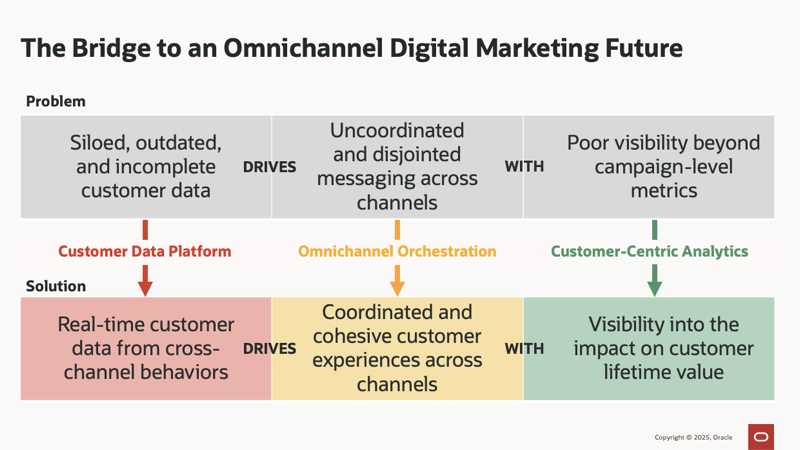Consumers have been omnichannel in their behavior for at least a decade, seamlessly shifting from one channel to another on their journey toward getting what they want. And B2B buyers have also gone omnichannel. To their frustration, however, most brands have struggled to move beyond their siloed multichannel operations. That has meant disconnected experiences and outdated messaging, which has been to the detriment of customer satisfaction and profits.
Thankfully, brands now have the tools available to them to finally catch up to the channel-hopping speed of their customers. With the following three components in place, brands are finally able to use real-time customer data from cross-channel behaviors to drive coordinated and cohesive customer experiences across channels with visibility into the impact on customer lifetime value.

1. Customer Data Platform
The personalization, segmentation, and automation of your messaging can only ever be as good as the data that’s flowing into your marketing platforms. That’s why customer data platforms (CDPs) are a critical starting point in upleveling your customer experiences. CDPs:
- Are an enterprise package solution (and therefore you should ideally only have one in your entire organization)
- Aggregate all customer data in one location from across your organization, giving you a single source of truth
- Resolve identifies, de-duping contacts and stitching together data based on customer, account, household, vehicle, and other information
- Have real-time capabilities, so data is up to date
- Provide data accessibility to all other systems for analysis and activation to create customer experiences
CDPs also provide a reliable data foundation for AI modeling and other tools, whether those are part of an omnichannel orchestration engine, an analytics package, or something else.
Related post: CDP vs. MDW vs. CRM vs. CDM vs. DMP: How They Differ & How They Might Work Together
2. Omnichannel Orchestration
Omnichannel orchestration allows brands to coordinate their digital marketing channels to create cohesive, unified campaigns across channels. This is accomplished through tight integrations between the platforms that drive individual channels, such as email, SMS, and mobile push marketing.
3. Customer-Centric Analytics
Most brands are drowning in campaign performance data and channel performance data. But this data doesn’t allow brands to understand how campaigns work together to drive successful customer journeys, especially when those journeys involve multiple channels, which most do.
This channel-centric view of performance also causes marketers to optimize individual campaign touchpoints instead of complete customer journeys, or to optimize specific channels instead of the overall customer experience. It also saddles them with attribution models that usually pit channels against each other instead of having them and their teams working collaboratively.
The alternative is to make the leap from data to insights through analytics and embrace longitudinal customer-centric metrics like customer lifetime value and annual revenue per customer. Along with holdout testing and A/B testing, optimizing for those metrics over time help prevent message fatigue and churn, both of which compromise long-term value.
At the tactical level, customer-centric analytics and predictive modeling can drive segmentation and personalization efforts. Some modeling to consider include:
- RFM modeling to determine which customers are in-market and which are not based on the recency of their last purchase, frequency of purchases, and monetary value of their purchases
- Activity modeling to determine which customers are likely to engage if messaged
- Fatigue modeling to determine which customers are likely to churn out of a channel if messaged again
- Channel affinity to determine which channel to message a customer based on their engagement with the channels they’ve opted into
- Next best action to determine which action a customer is most likely to take based on their recent actions
- Product category affinity to determine which categories a customer is most interested in
- Price sensitivity to determine the price bands a customer is most likely to respond to
- Discount receptivity to determine how a customer responds to different discount levels
While some CDPs have analytics capabilities, most don’t, or they have very limited functionality. Therefore, most organizations will want to bring more sophisticated analytics to bear.
Related post: 7 Advanced Digital Marketing Metrics Most Brands Don’t Use, But Should
All for One
Without all three of these components, digital marketing programs face significant failures. Without omnichannel orchestration, campaigns are uncoordinated and disjointed across channels. Without a customer data platform, customer data is siloed, outdated, and incomplete and duplicative records are created due to poor identity resolution. And without customer-centric analytics, campaigns and channels are optimized to the detriment of long-term customer value.
But with all three of these components, brands can finally create the kinds of experiences that consumers have expected from them for more than a decade.
—————
Need help moving into an omnichannel future? Oracle Digital Experience Agency has hundreds of marketing and communication experts ready to help Responsys, Eloqua, Unity, and other Oracle customers create stronger connections with their customers and employees—even if they’re not using an Oracle platform as the foundation of that experience. With an NPS of 66, our clients are thrilled with the award-winning work our creative, strategy, and other specialists do for them.
For help overcoming your challenges or seizing your opportunities, talk to your Oracle account manager, visit us online, or email us at OracleAgency_US@Oracle.com.
To stay up to date on customer experience best practices and news, subscribe to Oracle Digital Experience Agency’s award-winning, twice-monthly newsletter. View archive and subscribe →
